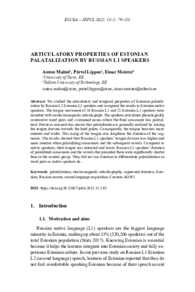Document
Articulatory properties of Estonian palatalization by Russian L1 speakers.
Identifier
DOI: 10.12697/jeful.2022.13.2.03
Source
Eesti ja Soome-Ugri Keeleteaduse Ajakiri. v. 13, 2, p. 79-118
Contributors
Lippus, Pärtel., Author
Meister, Einar. , Author
Country
Estonia.
City
Tartu
Publisher
University of Tartu Press.
Gregorian
2022-01-01
Language
English
English abstract
We studied the articulatory and temporal properties of Estonian palatali zation by Russian L1 Estonian L2 speakers and compared the results to Estonian native speakers. The tongue movement of 24 Russian L1 and 21 Estonian L1 speakers were recorded with an electromagnetic articulograph. The speakers articulated phonologically contrastive word pairs and i-stemmed nouns where the final consonant was palatal ized. Previous research has shown that palatalization is generally realized by raising the tongue dorsum towards the hard palate. Consequently, the tongue becomes more anterior and wider. This rising of the tongue also lengthens the duration of the seg ments. The results showed that Russian L1 speakers’ tongue dorsum was higher and more anterior when palatalizing consonants and the subsequent vowels. Compared to native speakers, their tongue was retracted and lower. Russian L1 speakers’ duration of palatalized consonants and the vowels that preceded them were significantly shorter than in the control group. They did not use duration to differentiate palatalization in word pairs as native speakers do.
ISSN
1736-8987
Category
Journal articles

